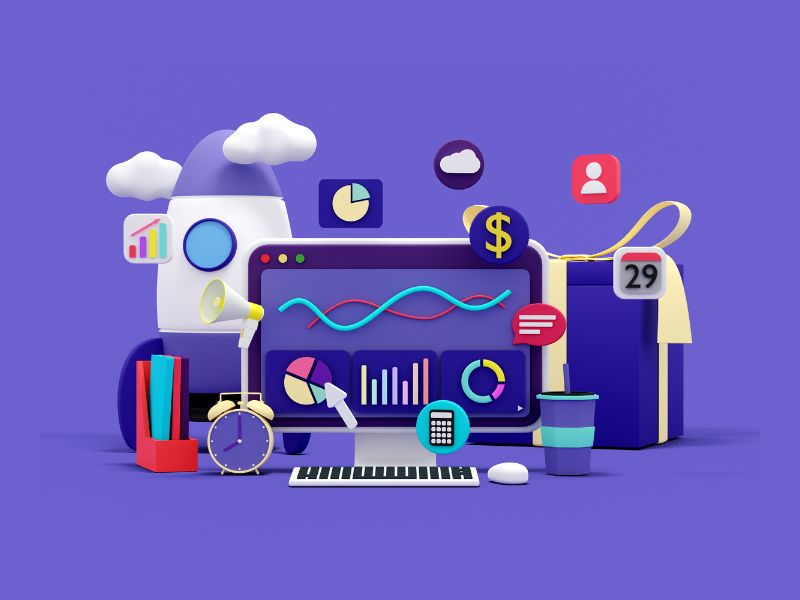Creating a great user experience (UX) is essential for any successful digital product. Great UX designs should be intuitive, easy to use, and provide users with a functional and rewarding experience when engaging with your website or application.
Data-driven design enables designers to customize the user experience by gathering and analyzing valuable user data. By merging analytics with UX design, designers can identify user behavior, preferences, and needs, leading to a personalized experience for all users.
Why Data Is Important
Data is the foundation of all digital products. By having a thorough understanding of user behavior through data collection and analysis, UX designers can make informed decisions. These decisions ultimately drive the design of digital products.
Data can tell us a lot of things about user behavior. For example, data can reveal which pages on the website are the most visited and which are being ignored. It can also give us insight into how long users typically spend on a page and what actions they take.
This information can be further analyzed to determine the pain points in the user experience. UX designers can use this data to redesign a website or app to improve the user experience.
Data can also help UX designers identify user personas based on demographics, interests, behavior, and more. By understanding user personas, UX designers can create targeted user experiences that cater to user-specific needs.
Without data, UX design would be based on assumptions and guesswork, leading to inconsistent experiences and design failures.
How Data Can Improve UX Design
Data is a powerful tool for improving UX design. By utilizing data-driven UX design, designers can optimize their designs based on user behavior and rely on analytics to evaluate their effectiveness.
The Importance of Knowing Your Market
Knowing your target market is necessary to design a product that meets their needs. However, you should also understand how they interact with your application, website, or product. Gathering user data on demographics, behavior, and preferences can be done through surveys and analytics.
You can gather data on both quantitative and qualitative aspects of the user experience. This includes data on page visits, time spent, calls to action actively engaged with, and other relevant user actions. This data can then be used to create targeted UX designs and help identify areas where improvements are needed.
Once analyzed, the data can inform a tailored user interface design that ensures a better client experience. Personalizing the user interface based on user needs and preferences is a way to enhance user engagement and create a pleasant and rewarding user experience.
Move Beyond Assumptions: Deliver What Your Audience Wants
Assumption-based design can be a recipe for failure. However, with a thorough understanding of user behavior and preferences, designers can ensure they focus on what matters.
Data-driven design allows for an evidence-based approach to user experience design. By analyzing data on user interactions, such as which features and pages are used more, you get a clearer view of what the user wants from the product.
This information allows you to design and perfect those features to achieve their desired outcome. All assumptions are eliminated, and your UX design is based on
user behavior and needs rather than guesswork.
Ready to elevate user experience with the power of data analytics?
Contact Growth Hackers
Creating a Better Brand Experience with Data-Driven Design
Data-driven designs also allow for consistency in brand identity across all platforms. When designing a website, app, or any other digital product, it’s essential to maintain the brand identity and ensure that all design elements represent the company’s core values.
A brand’s identity can be communicated through various aspects, including visual design, content, tone of voice, and other elements. Collecting data on user preferences and behavior can ensure that all these aspects are accurately represented in the design of your digital products.
Consistency across platforms such as websites, social media, and applications makes it easier for consumers to connect the brand identity with the product. This, in turn, creates a sense of loyalty to the brand and helps to leave a lasting impression on the user.
Make Better Business Decisions with Data-Driven Offer Insights
Data-driven UX research provides valuable insights for business decision-making. By analyzing your website’s customer journey and actions, you can optimize the design for conversions, leading to an increase in revenue.
How to Execute Data-Driven UX Design
To effectively execute data-driven UX design, following a specific series of steps is essential. Each step is critical in achieving your goal of creating a compelling user experience that drives business success. Here are some key ways to accomplish this:
Bring In Relevant Data
Data is at the heart of data-driven UX design. The first step is to gather and analyze relevant data. This includes both quantitative and qualitative data. Quantitative data may include information such as website traffic, conversion rates, and bounce rates. On the other hand, qualitative data may consist of user surveys, feedback, and behavior patterns.
It is crucial to analyze the data and look for patterns and trends. You can also segment the data by audience and demographics to better understand the user base. By understanding the data, you can make informed decisions about the user experience design.
Test Application Functionality
Testing application functionality is an integral part of data-driven UX design. This process helps to ensure that the application functions correctly and efficiently. There are various types of testing, including unit testing, functional testing, and user acceptance testing.
Unit testing is done on individual code units or components to ensure they function as intended. Functional testing is conducted to check specific features and ensure they work correctly. User acceptance testing is done to ensure the entire application is functioning as intended by testing it with actual users.
Testing is the only way to guarantee that the application works correctly and efficiently to provide a long-term user experience.
Build A/B Testing Scenarios
A/B testing is a powerful technique for optimizing website or application content and layout. It helps you compare two or more versions of a design element or feature and determine which performs better according to your specific goals. A/B testing can be done on various aspects of the user experience, including:
- Landing pages
- User interfaces
- Navigation menus
- Call-to-actions
- Registration forms
- Checkout processes
The goal of A/B testing is to perform experiments and make data-backed decisions to optimize the user experience. By comparing different versions of a feature or element, you can determine the best choice for your application or website.
Rely on Heat Maps and Behavior Flows
Heat maps and behavior flows are two essential tools in data-driven UX design. Heat maps visually demonstrate where users click and interact with your website or application. By analyzing the heat maps, you can gain insights into how users interact with elements of your website.
Behavior flows, on the other hand, highlight where users drop out or get stuck in the funnel. By analyzing behavior flows, you can determine where users are experiencing problems and improve the user experience for those specific elements.
Both tools can help you optimize your website or application by revealing areas that need improvement. By understanding how your users interact with your website, you can make informed decisions to enhance the user experience.
Transform user experiences today – harness data-driven UX design!
Conduct User Interviews
User research is the cornerstone of UX design, and conducting user interviews is a crucial part of this process. User interviews provide insight into user experience and behavior. These can be conducted in various forms, including surveys, questionnaires, and user testing sessions.
User interviews can help reveal user expectations and frustrations. By understanding user needs and pain points, you can improve your product accordingly, resulting in a superior user experience. It is essential to ensure that the interview questions are open-ended to gain an in-depth insight into user opinions.
Take Action on What You’ve Learned
Once you have gathered and analyzed data, identified areas for improvement, and conducted user research, it’s time to take action with your design ops processes. This may involve refining the UI design, optimizing user flows, or improving website functionality.
When implementing changes, ensure that they align with the goals of the user experience design. Also, consider observing users interact with the new changes to gather feedback and make further iterations.
Invest In UX Consulting Services
Investing in third-party UX consulting services is an excellent way to bring an objective perspective to your design process. In addition, these experts can help to execute a thorough UX audit which helps to provide valuable insights and recommendations based on industry best practices.
UX consulting firms provide a fresh perspective on your design process, defining clear user journeys and creating user-centric designs. They can help you optimize the user experience, align it with your business goals, and enhance user satisfaction with the help of UX design services.
Enhance Your UX Design with Valuable Data Insights
UX design is an ongoing process that requires data-driven insights. By leveraging A/B testing scenarios, heat maps, and behavior flows, user interviews, and third-party consulting services, you can enhance your website or application’s user experience to ensure users have a positive interaction with it.
With these strategies in place, you can optimize user experiences based on valuable data insights so that customers are more likely to stay engaged with your product. Make sure you take action on what you’ve learned by refining UI design and optimizing user flow for maximum efficiency.
Growth Hackers is an award-winning user experience agency helping businesses from all over the world grow. There is no fluff with Growth Hackers. We help entrepreneurs and business owners enhance and execute data-driven UX design effectively, increase their productivity, generate qualified leads, optimize their conversion rate, gather and analyze data analytics, acquire and retain users and increase sales. We go further than brand awareness and exposure. We make sure that the strategies we implement move the needle so your business grow, strive and succeed. If you too want your business to reach new heights, contact Growth Hackers today so we can discuss about your brand and create a custom growth plan for you. You’re just one click away to skyrocket your business.






